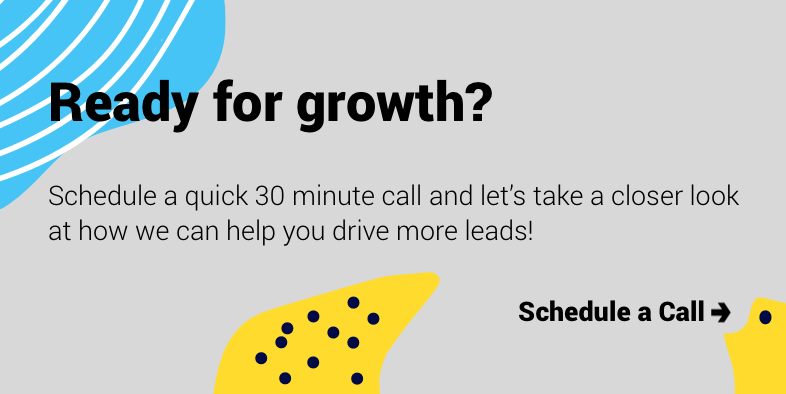“Your marketing funnel is dead!”
Well, that’s at least what everyone keeps saying!
But how?
Why?
I mean as marketers and salespeople the funnel has served us faithfully for years. Simplifying our understanding of how people engage with business on their journey to becoming customers.
As I watched Brian Halligan, the CEO at HubSpot, give his keynote at Inbound 2018 I felt a mild sense of panic rise. With several campaigns about to go live after months of work, had we missed the mark?
Were we about to embark on a journey into obscurity with an outdated understanding of how people and businesses engage?
Luckily, not!
Time to remove that little self-doubting devil from your shoulder and get a few things straight.
First, the funnel isn’t dead.
The way we visualise data and information will still take shape in a funnel. Let me show you…
Here’s a behaviour flow funnel from one of our Google Analytics accounts showing where users enter and how they move through the website.

Here’s a HubSpot marketing performance funnel showing simply how many visitors became contacts.

Here is one of our Databox funnels showing our organic keyword positions in the top 100. It’s particularly useful as we monitor it month-on-month to see our keyword growth.
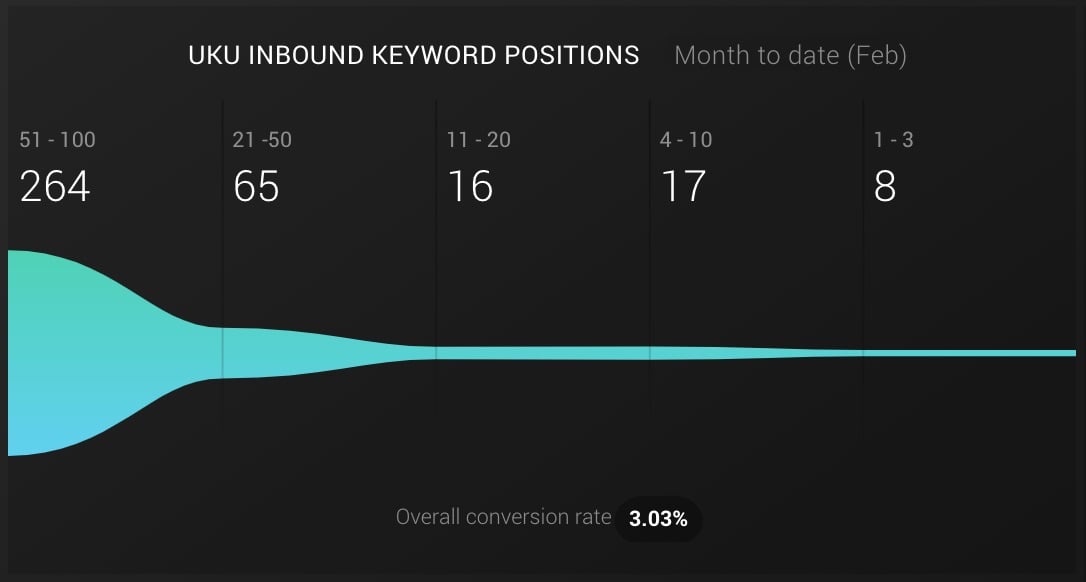
Finally, a sales funnel giving us insight into where the sales team is and how many deals they are working on.
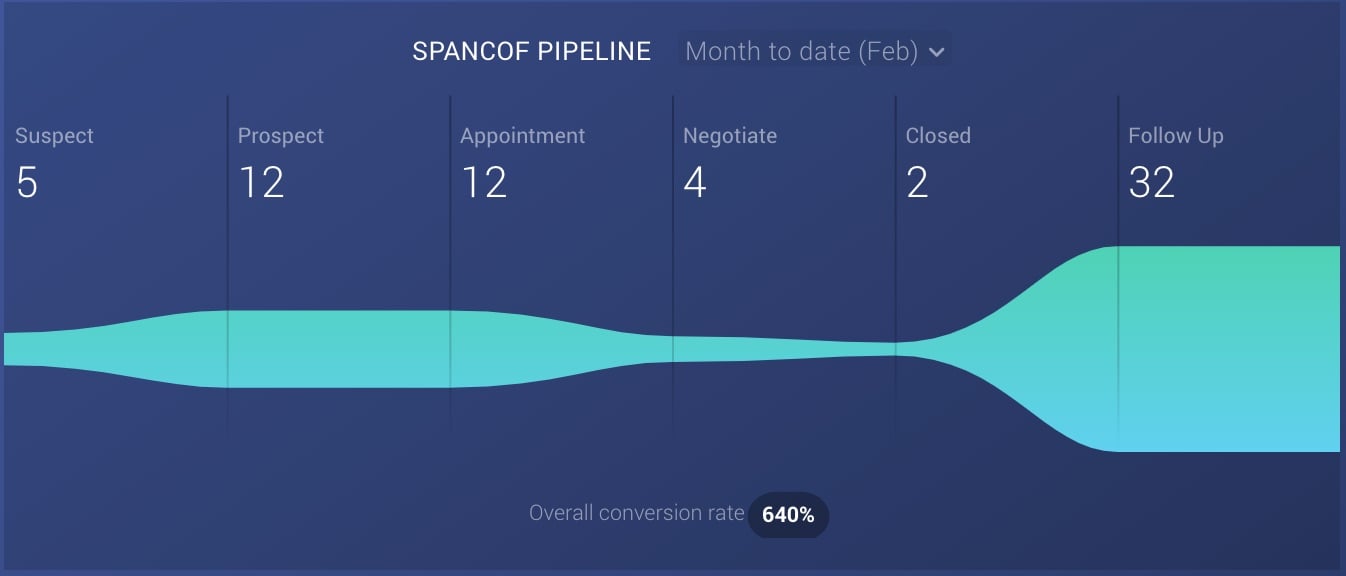
My point is that the funnel is certainly not dead.
Ok, so you are probably asking yourself…
“If the funnel isn’t dead then what’s all the fuss about?”
Good questions.
Although the funnel has been a very useful metaphor for us in the past, it does have quite a significant problem.
The funnel regardless if it is sales or marketing or customer service, is focused on input at the top.
More traffic means more leads, which means more opportunities, which in turn means more sales. True but not very efficient.
The focus in this funnel is on driving more traffic, while customers are just left to drain out the bottom. This defies quite a lot of conventional wisdom that customers are your best source of marketing. It also costs less to keep a customer happy than to acquire a new one.
Don’t believe me? Here are some stats to chew on:
-
Getting a new customer can be up to 25x more expensive than keeping an existing one - Harvard Business Review
-
A 5% increase in customer retention produces more than a 25% to 95% increase in profit in certain industries - Fredrick Reichheld (The inventor of the net promoter score)
-
Most businesses close 10% to 30% of their sales opportunities while referral-based sales close at between 50% to 70% and can often be higher - HubSpot
The point here is that if we can shift our focus, by effectively changing metaphors, we can focus on creating more value by solving for the customer instead of just viewing them as an output.
Need to drive growth in a hurry? Check out our 121 Digital Marketing Growth Hacks Guide ;) Click here
Say Hello to the Flywheel
The flywheel is very simple. It spins on an axis, the faster you spin it the more energy it stores and that ultimate speed depends on two things: friction and what it is made of (ie how much it weights and how big it is).
I'm not going to go into a lot of detail about the difference between the funnel and the flywheel, we created another blog about that. What you do need to know is that while a funnel loses momentum at the bottom a flywheel leverages that momentum to keep spinning.
The flywheel’s effectiveness is dictated by 3 factors:
- The speed it spins at.
The more force you apply the faster it will spin. Force can be anything that attracts, engages or delights customers.
You need to define these forces and they will ultimately vary from industry to industry. They can take the form of a well-written blog, making it easier for users to sign up to your platform or investments to drive customer success after their purchase has been made.
Here are a few examples of force in each area of the flywheel:
| Attract | Engage | Delight |
|---|---|---|
|
|
|
-
The amount of friction slowing it down.
Friction is bad. It slows down your flywheel and undoes the good work you have been trying to do. Poor alignment between marketing and sales is often a major sticking point which leads to poor close rates and targets missed.
Your aim is to try to remove as many points of friction as possible. A great example of a company doing it right is HubSpot. Over the last year, they introduced free products as an easy entry point, they build channels to encourage people to connect now instead of later, their sales process is aimed at solving for the prospect, and they offer a wide range of educational videos to help drive customer success.
Don’t let a prospect and most importantly a customer lose momentum because of overly convoluted processes, promises made and not kept, internal structures that don’t put the customer first.
Less friction, more speed!
-
What it’s made of, ie how big it is and how much it weighs.
As your flywheel spins faster and with less friction, it will start to grow. The growth becomes customers who add weight to your flywheel. Happy customers mean more weight, and as they refer more people you get more customers and your flywheel grows.
You’ll see conversion rates increase, the lifetime value of your customers will increase and they consume more of your products or services because you prioritise them.
Time to create your flywheel
At the end of his keynote, Brian Halligan handed out 3 homework assignments, which were the basic steps to follow to create your own flywheel. Here they are:
-
Assignment 1: Measuring the Flywheel
-
Assignment 2: Maximise Delight
-
Assignment 3: Reduce Friction
I’ve gone through each assignment and will take you through it step-by-step. If you’d like to do the assignments for yourself you can download the templates here:
-
Google Slides (Important Note: You will not be able to edit this template. You need to make a copy by clicking File > Make a copy)
Great. Let’s dive in, shall we?
Assignment 1: Measuring the Flywheel
The objective here is to understand what metrics are important to you. This will help guide you when deciding where to invest your time and resources and what will ultimately determine the success or failure.
Your instructions for this assignment:
-
Re-familiarise yourself with the fundamentals of the inbound marketing methodology
-
Identify the core activity or program associated with each stage of the flywheel
-
Identify the most important metric for each activity
Step 1: Re-familiarise yourself with the fundamentals of the inbound marketing methodology
Making sure we are on the same page is always a good idea.
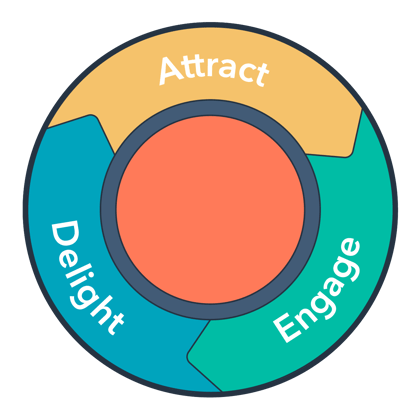
Here’s how we define each stage:
-
Attract: Provide value before you extract it. We want to attract strangers to become visitors to our website through content like blogs, webinars, and content offers. This will allow you to open up the initial channels from communication and foster meaningful conversations.
-
Engage: Make it easy to buy and shop. Build relationships, don’t just focus on closing. You want to provide value and help your prospect solve their challenges by providing insight and aligning your solutions to the customers' needs.
-
Delight: Customer success is your success. Invest in it. Help them achieve what they set out to achieve, provide excellent customer service and provide them with a customer experience that makes the sing your praises.
Step 2: Identify the core activity or program associated with each stage of the flywheel
Now that you know what each stage means, you need to identify the activities that drive each phase in your company.
Here a look at our core activities:
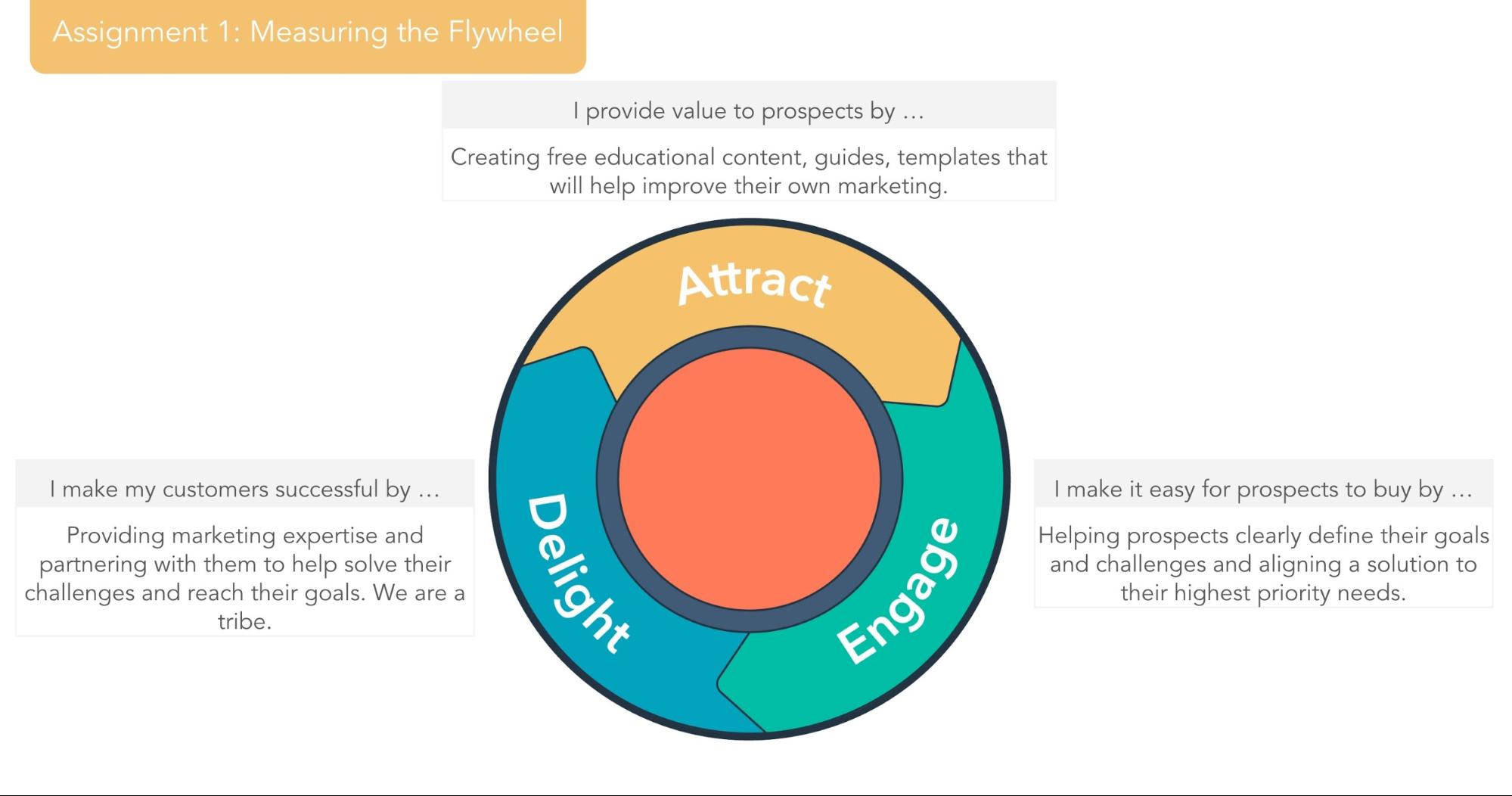
-
Attract: Naturally, as an inbound marketing agency, we focus on inbound marketing activities to drive traffic and foster those initial relationships. Blog posts, templates, video tutorials, webinars, guides are all aimed at creating value.
-
Engage: We make it easier for a prospect to buy by helping them clearly define their goals and challenges and only then aligning a solution to those needs. There is no point in forcing a one size fits all solution onto clients. They won’t buy into the plan and it probably won’t work.
-
Delight: By focusing on client success, it makes aligning marketing, sales and customer service a whole lot easier. We create content that helps educate our clients and upskill their teams. Our sales process helps define goals and challenges and ultimately make sure we are a good fit for them. Then when our client services take over delivery we partner with our clients to help them solve their challenges and reach their goals.
Step 3: Identify the most important metric for each activity
Now it’s time to decide which metric you will use to track each activity. You need to try keep it relatively high-level to ensure that you can clearly track progress in each phase.
Here are some examples of high-level metrics that you could use:
| Attract | Engage | Delight |
|
|
|
At Uku our Attract metric is monthly website visits. It’s a simple metric and allows us to keep track of which channels drive the most traffic. We also keep a close eye on organic traffic. The aim is to make sure our organic traffic makes up a growing portion of our overall website visits.
For the Engage phase, we look at two metrics: sales qualified leads and customers.
Firstly, we look at our SQL’s, which are leads that show a high level of interest and connect with our sale team. Our sales process is consultative so the first step is to setup up a marketing assessment call to try to understand our potential customers' goals and challenges.
Next, we look at how many of those SQL’s are ready to buy and turn into paying customers. We keep track of their campaigns and how long we work together. If a campaign or engagement ends, it slows down our flywheel so we are very focused on customer success.
Finally, in the Delight phase, we focus on the Net Promoter Score. We track this quarterly and it effectively measures how willing our customers are to refer us and how many of them aren’t.
Assignment 2: Maximising Delight
Great! Now that you have identified the core activities in each phase the next assignment is aimed at optimising the forces that spin your flywheel to maximise delight.
Here are your instructions for this assignment:
-
List out the forces that move your customers through the flywheel.
-
Describe whether they are designed to serve your customers’ needs or your own process/convenience.
-
Update each force so it maximises customer delight.
If you are just starting out then it makes sense to focus on the Attract and Engage phases as you need to first have customers before you can delight them.
Once your flywheel starts spinning through and no matter how slowly you’ll generate most of your momentum from delighting your customers. Turning them into advocates for your business is the most effective way to generate more speed and fuel your growth.
I went ahead and put together a list of our marketing, sales and customer service forces and where we have or are planning to maximise delight.
A quick note, this list is not exhaustive. I highly recommend having several people from each team add to your list of forces.
|
Marketing Forces |
Currently... |
To maximise delight... |
|---|---|---|
|
Content offers |
Marketing focused ebooks. |
Create more practical tools and templates. Less theory more coaching. |
|
Blog content |
Inbound marketing focused. General. |
Create helpful blog content with a specific buyer persona in mind. Speak directly to their pain points and needs. |
|
Conversion path |
Forms on landing pages. |
Prospective customers can now use website chat, book a meeting, call or simply fill out a form. |
|
Backlinks |
Focused mainly on directories, Quora and Medium. |
We now create more guest blog posts and contribute to external blogs. |
|
Social media engagement |
One way communication, a lot of sharing less interaction. |
50% real-time content, actively engage with and share high-value content. Have more conversations. |
|
Sales Forces |
Currently... |
To maximise delight... |
|
Sales process |
Undefined. |
Create a clear path to becoming a customer. |
|
Lead nurturing |
One dimensional lead nurturing. |
Create highly personalised lead nurturing to improve relevance and add value. |
|
Packages |
Poorly defined. |
Create simple packages that create more value than they extract. |
|
Pricing |
Tokens not hourly rates. Lack of transparency. |
Change to points and improve client communication to ensure transparency. |
|
Service Forces |
Currently... |
To maximise delight... |
|
Support |
Phone, email. |
Dedicated single point of contact. |
|
Reporting |
Standard high-level metrics. |
Provide more frequent updates with strategic insights. Real-time reporting with custom dashboards. |
|
Customer feedback |
Informal. |
Create quarterly NPS. |
|
Customer education |
Ad-hoc training when needed. |
Provide formalised workshops. |
|
Project management |
Weekly emails updates and in-person meetings. |
Access to Trello and Slack for better collaboration and more transparency. |
Assignment 3: Reduce Friction
Well done! You’re almost there.
Reducing friction is the final piece of your flywheel puzzle.
There are 4 steps you need to follow:
-
Identify your points of friction.
-
What can be automated?
-
For friction points that can’t be smoothed with automation, what can be addressed through shared goals?
-
If shared goals won’t resolve the points of friction, what can be addressed through team reorganisation?
Step 1: Identify your points of friction
There are countless ways to identify points of friction.
The good news is that there are most likely a few glaringly obvious ones like low visitor-to-lead rate, high abandon cart rates, how many users successfully complete their onboarding process, how many churn, or poor reviews.
These are pretty easy to spot, benchmark against past performance or industry standards and consequently improve.
The bad news is that there are some points of friction that are not as obvious. Stuff like organisational structure, poor marketing and sales alignment, company culture, internal politics that detract from the companies effectiveness and ultimately lower the customers' experience.
Let’s take a look at some of Uku’s points of friction:
| Sources of Friction | Can we fix this with... | ||
| Automation | A new goal? | Reorganisation | |
| Prospects want quick responses to some immediate questions regarding services and pricing. | |||
| Customers aren’t looking at reports and dashboards. | |||
| Lead nurturing is generic and sales follow up is slow. | |||
| MQL and SQL identification is ambiguous. | |||
| Currently, the NPS is unknown. | |||
| Sales deals with a lot of businesses who don’t fall within our target market. | |||
| SQL’s were not being followed up with quickly and consistently. | |||
Step 2: What can be automated?
Automation is a great way to improve efficiency and free up time. Tasks that are repetitive or don’t need a human to be involved with are perfect for automation. This will give your team more time to work on tasks that are important to your customers.
Our guiding principle here is that if it can be automated then it probably should be.
| Sources of Friction | Can we fix this with... | ||
| Automation | A new goal? | Reorganisation | |
| Prospects want quick responses to some immediate questions regarding services and pricing. | Yes. Introduce live chat and support bot to improve user responses. | ||
| Customers aren’t looking at reports and dashboards. | Automate reporting to communicate more frequently. Focus on a few high-value items instead of large general report. | ||
| Lead nurturing is generic and sales follow up is slow. | Yes. Create automated sequences with specific buyer persona messaging. | ||
| MQL and SQL identification is ambiguous. | Redefine MQL and SQL. Automate identification to highlight which users sales must focus on. | ||
| Currently, the NPS is unknown. | No. | ||
| Sales deals with a lot of businesses who don’t fall within our target market. | No. | ||
| SQL’s were not being followed up with quickly and consistently. | No. | ||
Step 3: What can be addressed through shared goals?
We’ve all been in those meetings where the tension between sales and marketing flares up. Sales blames marketing for the low deal count because of the quality of the leads they are getting.
Meanwhile, the customer service team is blaming their high churn rate on sales because they are signing up anyone with a pulse.
These points of friction occur because teams are misaligned. A slight adjustment can easily resolve some of these issues and have everyone on the same page.
| Sources of Friction | Can we fix this with... | ||
| Automation | A new goal? | Reorganisation | |
| Currently, the NPS is unknown. | No. | Create an NPS survey and set a target for sales and customer service teams. | |
| Sales deals with a lot of businesses who don’t fall within our target market. | No. | Service level agreement between sales and marketing to produce high quality leads from within our target industries. | |
| SQL’s were not being followed up with quickly and consistently. | No. | No. | |
Step 4: What can be addressed through team reorganisation?
If you have reached this point and you still have some points of friction that automation and new goals cannot fix then you need to consider some reorganisation.
Do customers need to be continually passed along across several functions before they get to the right person? Do the same issues pop up time and time again? Is there a skills gap that is adding friction?
| Sources of Friction | Can we fix this with... | ||
| Automation | A new goal? | Reorganisation | |
| SQL’s were not being followed up with quickly and consistently. | No. | No. | We clearly defined our sales process and assigned responsibility. |
There you have it!
If you have reached this point you should have a pretty clear picture of your flywheel.
Now get your team involved, run them through your ideas to maximise delight and show them where the points of friction are. Let them help you build onto your ideas.
Once you are done you’ll have a pretty clear idea of what needs to be done and you and your team can get to work implementing those changes.
Need help with your flywheel? Schedule a quick 30-minute call with us and we will help create your flywheel, maximise delight and remove those pesky points of friction.



